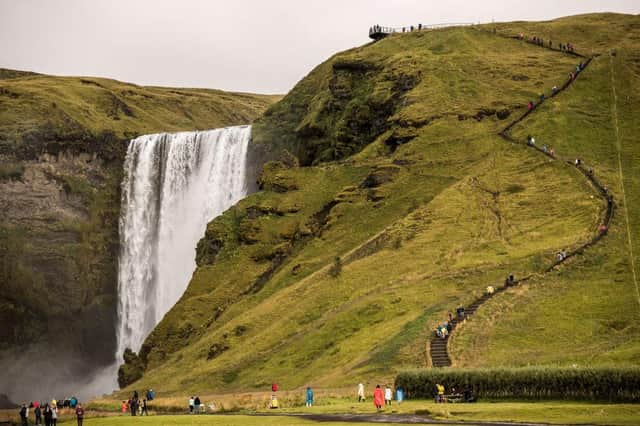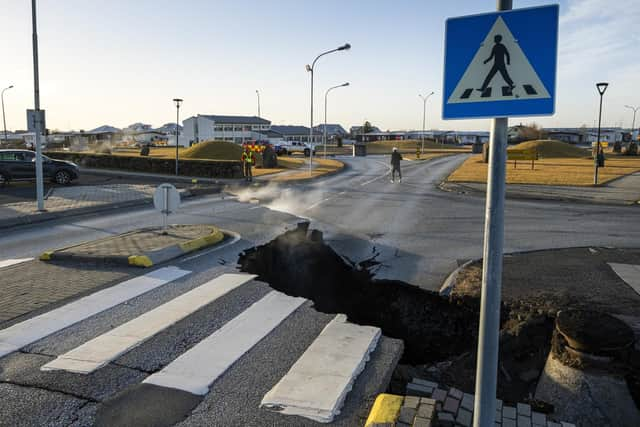Will Iceland's booming tourism industry be hit by fears over volcanic eruptions?


Snorri Valsson is not unaware of the irony that the same tendency for seismic activity which propelled Iceland into the consciousness of global travellers 13 years ago could potentially have the opposite effect now.
“Tourism was a small side business until 2010, when Eyjafjallajökull put us on the map with the eruption – showing us that any publicity is good publicity,” says Icelandic Tourist Board spokesman Mr Valsson, referring to the volcanic eruption which famously closed down European air travel for weeks due to fears that volcanic ash could affect aeroplane engines.
“Now it is one of the backbones of the Icelandic economy.”
Advertisement
Hide AdAdvertisement
Hide Ad

Iceland has seen an unprecedented tourist boom in the ensuing 13 years since the eruption of Eyjafjallajökull. Visitor numbers grew by more than 400 per cent between 2010 and 2018, when they reached more than 2.3 million – and have quickly rebounded since the pandemic, reaching 1.7m in 2022.
But now, Iceland is facing a “sustained period of seismic activity” following a series of earthquakes near the town of Grindavík on the Reykjanes Peninsula, which was evacuated in November amid fears of another volcanic eruption – and the eventual eruption itself on 19 December. Tourism experts say fears of further disruption from seismic eruptions could put off some visitors, slowing the meteoric rise in the tourist industry, which generates almost 9 billion krona (£508m) a year for the Nordic nation of just 370,000 people – around five per cent of Gross Domestic Product (GDP).
In early November, huge cracks appeared in the streets of Grindavík as magma spread underground for a distance of more than 6.2 miles, and more than 900 earthquakes were recorded in one day alone. Meanwhile, the Blue Lagoon thermal spa – a popular attraction among most visitors due partly to its proximity to the country’s main Keflavik airport – was closed for weeks, reopening just days before the volcano erupted, before being forced to shut its doors again.
Icelandic Met Office officials said in early December that the flow of magma has likely stopped, reducing the chances of an imminent eruption – just weeks before lava began to pour from a two-mile long crack in the earth’s surface. However, it is believed the likelihood of further eruptions could remain heightened for some time.
“There's a lot of uncertainty in this situation,” Mr Valsson says. “But we always emphasise that this is a localised seismic event limited to the area around Grindavík and the rest of the island is just business as usual. But it's understandable that some people might be disturbed by the news.”
He points to other recent seismic activity on the peninsula. The recent volcanic eruption is said to be far bigger than any other which has taken place in Reykjanes in recent times.
“You have to keep in mind that the Icelandic authorities are very well prepared for events like this,” he says.
The Blue Lagoon, which was refurbished in 2016, increasing the size of the bathing area by almost half and constructing a £2.4m five star hotel, is one of the success stories of Iceland’s tourist boom.
Advertisement
Hide AdAdvertisement
Hide AdLast year, the company behind the attraction announced plans to list on Iceland’s stock exchange. It was at the time said to have an estimated capital value in the range of 58-62 billion krona (£330m-£353m).
“The Blue Lagoon has become quite a trademark for selfies,” says Mr Valsson. “But there are other lagoons which are not the same, but similar. Tourists have other options as well, but we hope they can open as soon as possible.”
Residents of Grindavík are still not allowed to return to their homes.
With a population of just 3,600 people, the town is home to the Icelandic Saltfish Museum and various fishery operations. In recent weeks, locals have been allowed to access the town during daytime hours – to collect possessions, or work in fish processing businesses, but are not allowed to stay overnight.
Evacuation shelters were set up immediately following the incident for those displaced from their homes in Grindavík, however, within two days all affected families had found alternative accommodation, either in rented properties or with friends or family.
Mr Valsson believes that, in the long term, the seismic activity could, rather than deterring tourists, put Grindavík on the visitor map.
“I can imagine that when things have quieted down that will be quite an interesting place to visit and see with your own eyes what happened,” he says. “It’s quite an interesting sight to see.”
Christopher Greenwood, senior research fellow at the Moffat Centre for Travel and Tourism Business Development at Glasgow’s Caledonian university, agrees. He says data shows tourists are more likely to be put off travelling by a sudden event – but longer term issues which build over time are less likely to deter visitors, if they can plan around them.
Advertisement
Hide AdAdvertisement
Hide Ad“It will have an impact in the short to possibly mid-term,” he says. “Volcanic activity is inherently unpredictable and this may put off people who perhaps were planning a trip in the future – they will choose somewhere else now.
“However, if the infrastructure remains undamaged or repairable following the period of disruption, Iceland has a good reputation as a tourism destination and I can see it recovering in the long term.”
He points to destinations which have seen a resurgence in travel following major incidents, including Hawaii, where there was an uptick in tourists visiting settlements damaged by lava following a volcanic eruption earlier this year.
He says: “Travellers are on the whole resilient and if the destination infrastructure isn’t significantly impacted by damage then visitors will return quite quickly – indeed there is sometimes a macabre fascination with the aftermath or benefit to the traveller in obtaining a bargain price.”
He adds: “Another example was following the Arab Spring in Egypt – following the UK Foreign Office's advice to allow travel again, low-cost airlines started flights which resulted in UK travellers returning in significant numbers to Red Sea resorts due to the cost-benefit against the perception of safety.”
Some may argue a slight drop in the number of tourists may not be a bad thing for Iceland. The country had already been considering introducing a tourist tax to help combat the environmental effect from the high numbers of visitors. Concerns have been raised over the effect of so many travellers on the rural landscape, particularly in areas close to the capital, Reykjavik, where many visitors embark on a trip around the Golden Circle, which takes in geysers and waterfalls.
Comments
Want to join the conversation? Please or to comment on this article.
